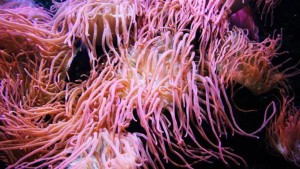Sea anemones are a common sight on many coastlines, and despite their brightly colored appearance it seems they may have more common with humans than people realize. What’s more, researchers are wondering whether the creatures could hold the secret to eternal life.
Once thought to be plants, sea anemones are soft bodied animals that attach themselves to rocks and coral reefs in shallow waters. Their tentacles inject venom into the small fish and shrimp that brush up against them and guide the paralyzed prey into the mouth, an opening that also functions as an anus.
There are more than 1,000 species of anemone, varying in size from a few centimeters to more than a metre across. They live in every ocean, from the warmest to the coldest. The most familiar in the UK is the beadlet anemone. At low tide the tentacles are drawn in and the animals look like blobs of deep red jelly stuck to the rock. But as the water flows, the blobs transform and start to resemble flowers, their tentacles caressing the moving water, searching for food.
The “wondrous elegance of form, the exquisite brilliance of colours, the great variety, the instincts, the powers, the most elaborate apparatus, bestowed on these humble creatures,” is described by 19th Century marine biologist Philip Henry Gosse in his book A Year at the Shore. His effusive prose inspired a nation that was just beginning to explore the seaside. His readers used to gather anemones and kept them in aquariums at home.
Usually the anemones didn’t live long but in the right conditions it could have been a very different story. “As far as we know, these are immortal animals,” says Dan Rokhsar, professor of genetics at the University of California, Berkeley. “They live a very long time, one was documented to have lived 100 years. They don’t have old age. They live forever and proliferate, just getting bigger.” If you cut off their tentacles, they grow new ones. Even if you cut off their mouths they grow new “heads.” As long as they are not poisoned or eaten, as is often the case, they seem to go on and on.
For more information, please visit: www.berkeley.edu

